Rusty Patched Bumble Bee. Photo credit: Xerces Society / Rich Hatfield
Rusty Patched Bumble Bee carrying pollen. Photo by: Tamara Smith/ USFWS
Fact File
Scientific Name: Bombus affinis
Classification: Insects, Order Hymenoptera, Family Apidae
Relatives: other bumble bees
Conservation Status:
- Federally Endangered in the U.S.
- Species of Greatest Conservation Need-Tier 1a on the Virginia Wildlife Action Plan
- Listed as Endangered under the Species at Risk Act in Canada
- Ranked as a G2S1 species (globally imperiled and critically imperiled in Virginia) by Virginia DCR's Natural Heritage Program
Size: (in length) queen: 21-22 mm, male: 13-17.5 mm, worker: 11-16 mm
Life Span: Colonies are seasonal with an annual cycle of April - October
Identifying Characteristics

Rusty Patched Bumble Bee. Photo credit: Tamara Smith/ USFWS
The bee gets its name for the distinctive rust-colored patch on its rear body segment (called the abdomen). This rusty patch is located on the center of its second abdominal segment, which is yellow. The patch is only found on the males and female workers. The queens do not have the rusty patch, making their identification much more difficult. (Please do not seek out the queens. It’s best to leave them be.)
All Rusty Patched Bumble Bees have solid black heads and a patch of black hair on top of their head. Additionally, a hairy black band stretches between each wing.
The largest bee in the colony is the queen, followed by the males, and the smallest are the female workers.
Similar Species
Within their Virginia range, the most similar-looking and easily confused bee with male and female worker Rusty Patched Bumble Bees is the Brown-belted Bumble Bee (B. griseocollis). The Brown-belted is also one of the three most common bumble bees in this region, so it is far more likely to spot a Brown-belted than a Rusty Patched. To distinguish the two, look closely at the abdomen (rear) of the bee.
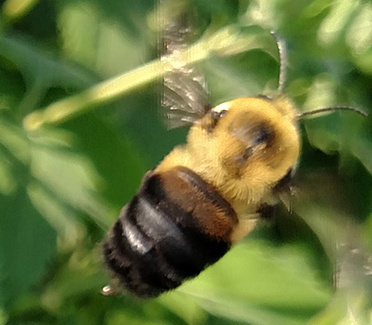
Brown-belted Bumble Bee. Photo by Kim Mitchell/ USFWS.
The Brown-belted has a solid brown patch in the middle of its second abdominal segment. This patch is a crescent moon shape and flanked by black hairs, whereas the Rusty Patched Bumble Bee’s rusty colored spot sits isolated within a “sea of yellow” on the second abdominal segment.
For further help with distinguishing the Rusty Patched Bumble Bee from the Brown-belted and other bee species, refer to The Xerces Society’s Pocket guide to Identifying the Rusty-patched Bumble Bee.
Habitat
Habitats are primarily grasslands and tallgrass prairies, but this habitat generalist also lives in woodlands and pastures, particularly in Virginia. These ground-nesting bees typically nest in abandoned rodent cavities, 1-4 feet below ground, or occasionally in clumps of grasses above ground. Hibernating queens overwinter in undisturbed soil, a few inches below the surface.
Diet
pollen and nectar from flowering plants
Distribution:
Currently ranges through 13 scattered Eastern and Upper Midwest states in the U.S. and 1 Southeastern Canadian province. In Virginia, it is only found in the counties of Fauquier, Augusta, Bath, Highland and Rockingham, representing a fraction of its historic distribution in the Commonwealth.
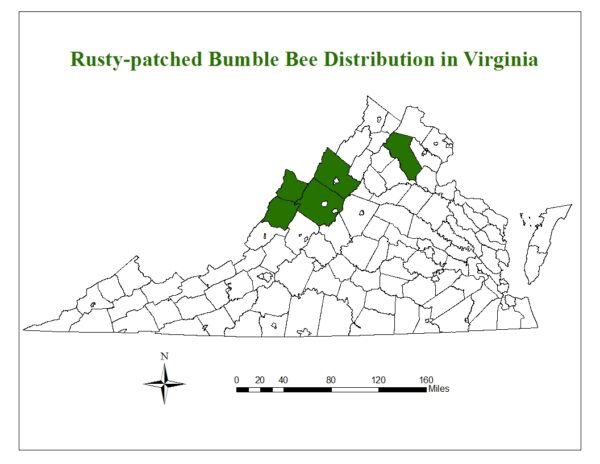
Colonial Life
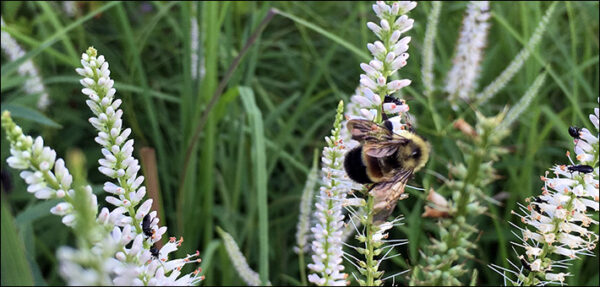
Rusty Patched Bumble Bee. Photo by Sarah Warner/ USFWS.
The Rusty Patched Bumble Bee is a highly social species that lives in colonies consisting of a single queen, female workers, and males. Their colonies are considered large compared to those of other bumble bee species; a healthy Rusty Patched Bumble Bee colony may contain as many as 1,000 individual workers.
In the spring, queens emerge from their underground hibernation. They initiate a colony by seeking a nest site, collecting nectar and pollen from flowers, and laying eggs. From these first eggs, hatch the workers. Workers build the colony; they collect food, care for young, and defend the colony. Meanwhile, the queens stay in their nests and continue laying eggs. Towards the end of summer, these eggs begin hatching males and new queens. The males leave the colony to mate with queens from other colonies. In the fall, the entire colony dies, except for the new queens; they remain as as the sole survivors. These new queens hibernate over winter and the cycle begins again in the spring.
Role in the Web of Life
Watch: Rusty Patched Bumble Bee Pollinating Purple-flowering Raspberry : Video by Sarah Warner/ USFWS
Bumble bees are very effective pollinators, making them a keystone species. They play a critical role in maintaining our food supply and keeping our ecosystems healthy. They are essential to native wildflower reproduction and the growth of seeds and fruits that feed a diversity of wildlife, from birds to bears.
Bumble bees are particularly important pollinators because they are “buzz pollinators,” a pollination process in which the bee vibrates its flight muscles while clasping a flower, dislodging pollen that is difficult to access. This process can make them a more effective pollinator of certain plants than other bees, such as honeybees, that do not buzz pollinate. It also is what makes them highly efficient pollinators for many crops. They are vital to tomatoes (one of the only insects that can pollinate them) as well as cranberries, blueberries, plums, apples, peppers, and alfalfa.
Where to See in Virginia
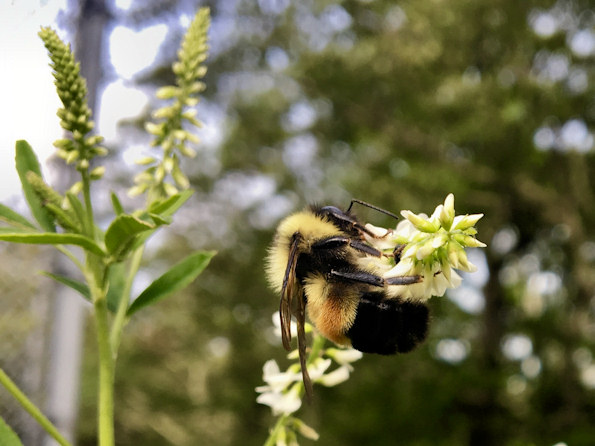
Rusty Patched Bumble Bee observed in Bath County, Virginia. Photo by Ellison Orcutt/ DCR Natural Heritage Program.
Rusty Patched Bumble Bees are currently only known to five counties in Virginia: Fauquier, Augusta, Bath, Highland and Rockingham. The later four, more western counties, have a slightly greater abundance, making them your best bets for finding the bee. However, even within those counties, their populations are extremely low, making it very rare to spot them.
To increase your chances of finding a Rusty Patched Bumble Bee, search for them in July, which is the best time of year to spot one in Virginia.
To view other bumble bee species, check out the DWR’s pollinator projects at the public lands described in the Conservation section below.
Conservation
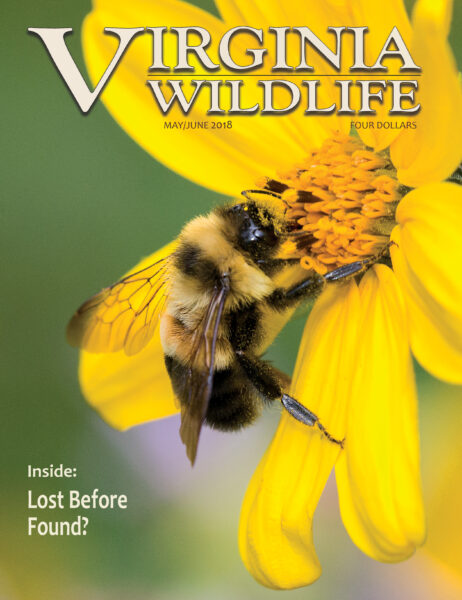
Virginia Wildlife magazine cover from 2018 featuring a Rusty Patched Bumble Bee. Photo credit: Clay Bolt
The Road to Recovery
The Rusty Patched Bumble Bee is the first-ever bumble bee to be listed as an endangered species in the United States. Once common to the Eastern US, Midwest, and part of Southeastern Canada, this bumble bee has declined over the last twenty years from an estimated 87% of its historic range. In Virginia, the bee historically ranged throughout most of the Commonwealth’s mountain region and western piedmont, extending into the center of the state and the Northern Neck, but now remains in just five counties. In January of 2017, the U.S. Fish and Wildlife Service (USFWS) listed the Rusty Patched Bumble Bee as an endangered species under the Endangered Species Act.
Multiple pressures have likely contributed to this bee’s dramatic decline, including disease, habitat loss and degradation, intense farming practices, pesticides, and climate change.
One of the biggest threats to the bee may be a pathogen called Nosema bombi, a disease that affects reproductive health and fitness of bumble bee colonies, among other issues. Evidence has shown that this disease may have spread into the wild from commercial bee colonies and the increased incidence in the wild follows the timeline of commercialization. Rusty Patched Bumble Bee is one of the few bee species known to have had high incidences of the disease.
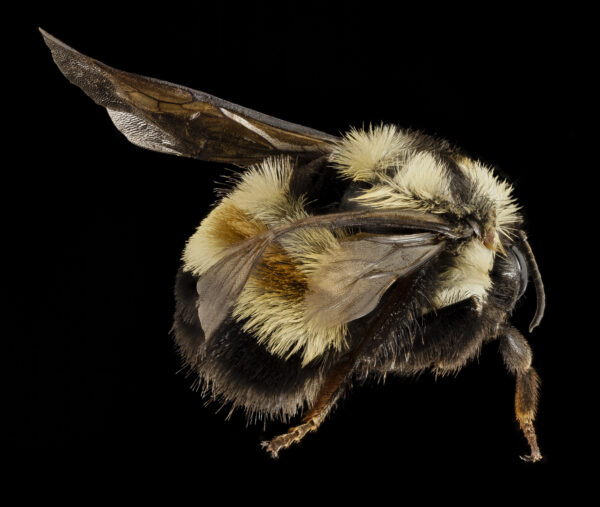
Rusty Patched Bumble Bee specimen from Fauquier County, Virginia. Photo by Sam Droege/ Smithsonian National Zoo.
Habitat loss and degradation have also had a particularly negative impact on this and other bee species. Most of the prairies and grasslands in the bee’s historic range have been lost to urban and agricultural development, leaving the remaining grasslands isolated and small. Intense farming practices further the harm to bumble bees from their increased use of pesticides and low to no plant diversity.
Climate change challenges native wild bees with weather extremes, early snow melts, and late frosts. Bumble bee spring emergence may also become out of sync with the blooming of spring flowers. Additionally, historical data shows that bumble bee ranges are contracting, and their populations are moving north and also up to higher elevations.
Since listing Rusty Patched Bumble Bee as a federally endangered species, the USFWS developed a draft recovery plan for the bee in 2019, which contains a list of actions to address these threats, stop the bee’s decline, and prevent its extinction.
In Virginia, the lead state agency for federally endangered insects, such as the Rusty Patched Bumble Bee, is the Department of Agriculture and Consumer Services (VDACS). VDACS has been working with the Department of Conservation and Recreation’s Natural Heritage Program on the inventory and documentation efforts for the Rusty Patched Bumble Bee. Since beginning those surveys in 2018, the Natural Heritage program has documented four new occurrences of the bee in Virginia.
What the DWR Has Done/ Is Doing
DWR is the lead agency in Virginia for the conservation of wildlife and wildlife habitat. This includes conservation for any insects that are not listed as federally or state threatened/ endangered, making DWR responsible for the majority of Virginia’s pollinator species. Therefore, we have been working on improving pollinator habitat at our Wildlife Management Areas and Lakes and on private lands throughout the state. The nature of this work improves habitat conditions for the Rusty Patched Bumble Bee, one of the priority actions listed in the USFWS’s Draft Recovery Plan for the bee. DWR also offers education and outreach on pollinator habitat.

A Rusty Patched Bumble Bee observed at Highland WMA. Photo Credit: Ellison Orcutt/ DCR Natural Heritage Program
Improving Pollinator Habitat
- Highland Wildlife Management Area (Highland County) – In 2020, DWR and DCR’s Natural Heritage Program documented 10 Rusty Patched Bumble Bees on Highland WMA; a significant finding as only three bees had been documented in the original 2018 survey. Furthermore, one of the documented bees was observed in a field that DWR recently began restoring. This field had previously been degraded by a long history of cattle grazing and had been taken over by non-native timothy grass, so in spring of 2020, DWR started the process of transforming it back to a native wildflower meadow by conducting a controlled burn and treating it with herbicide. The presence of the endangered bee in the newly restored meadow demonstrates that DWR’s efforts are yielding positive results for pollinators. The DWR maintains 44 acres of native wildflower meadow habitats at Highland WMA (and an additional 7 acres are being added in 2021 thanks to DWR’s Restore the Wild fund). DWR maintains these meadows through controlled burns, small timber sales, and by seeding old logging roads with native plants. These habitats benefit pollinators and a wide array of other wildlife.
- Lake Shenandoah (Rockingham County) – DWR and partners transformed the western arm of the lake property from mowed lawn into a meadow habitat for pollinators. Beginning in the spring of 2015, DWR staff and volunteers prepared the 2 acre area and planted native wildflowers and grasses attractive to pollinators. Continued maintenance in collaboration with the Virginia Master Naturalists has led to the success of this project. Other restoration and management efforts have included prescribed burns to control woody vegetation and stimulate growth of native plants. Additionally, interpretive signs, outreach programs, and community meetings have been supported by a number of other organizations.
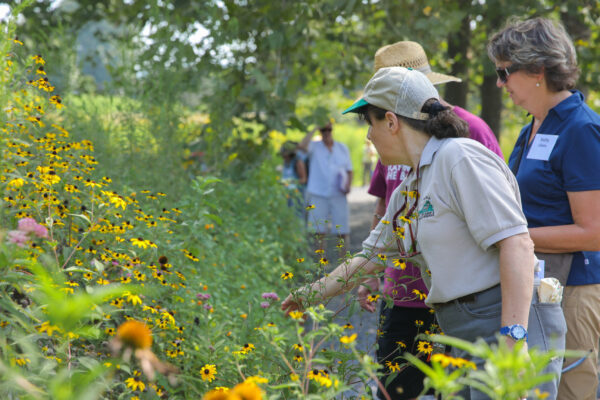
DWR pollinator workshop held at the pollinator habitat at Lake Shenandoah. Photo by Meghan Marchetti/ DWR.
- Goshen Wildlife Management Area (Rockbridge and Augusta County) –This primarily forested WMA contains a special open habitat called, “The Meadow Ground,” a 35-acre high-elevation meadow. DWR maintains a diversity of native wildflowers and grasses in this meadow with controlled burns and herbicide treatments in order to support pollinators and grassland birds.
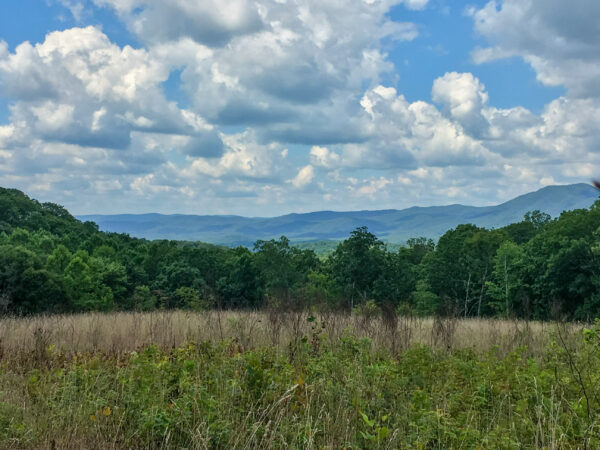
A meadow at Goshen Wildlife Management Area. Photo by Meghan Marchetti/ DWR.
- Vic Thomas State Fish Hatchery (Campbell County) – In 2018, DWR created about 3 acres of pollinator habitat on the Hatchery grounds. DWR planted native seed mixes appropriate for the upland and wetland areas of the site. The project reduced lawn mowing, improved wildlife habitat, and created an educational opportunity for the public. With the Hatchery being located close to the Town of Brookneal, the local community heavily uses the area for walking, so DWR also created interpretive signage about pollinators for the project site. In 2020, with funds from Restore the Wild, DWR will expand this habitat by adding an additional 5 acres of wildlife-friendly native shrubs along a hillside and pollinator plantings.
- Cumberland State Forest (Cumberland County) – In 2017, DWR and the Department of Forestry (DOF) created 5 wildflower meadows, totaling 8 acres of pollinator habitat, at the State Forest as part of a national grant that encouraged partnership between forestry and wildlife departments.
- Amelia Wildlife Management Area (Amelia County) – In 2017, DWR created 5 acres of wildflower meadows at Amelia WMA to provide habitat for pollinators.
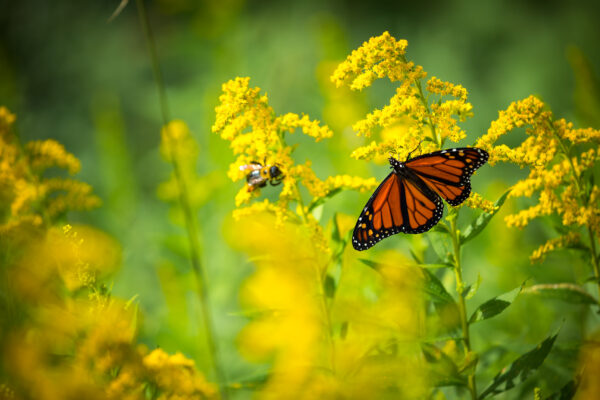
Pollinators foraging in a wildflower meadow at Amelia WMA. Photo by Meghan Marchetti/ DWR.
- Big Woods Wildlife Management Area and Big Woods State Forest (Sussex County) – In 2018, DWR began renovating 20 old logging decks (degraded open areas where timber had formerly been sorted and loaded onto trucks). DWR and DOF planted those areas with a pollinator seed mix and we have been conducting controlled burns to encourage growth of the native seedbank, which includes multiple wildflowers beneficial to pollinators. This project was partially funded by the National Wild Turkey Federation.
Education and Outreach on Pollinator Habitat
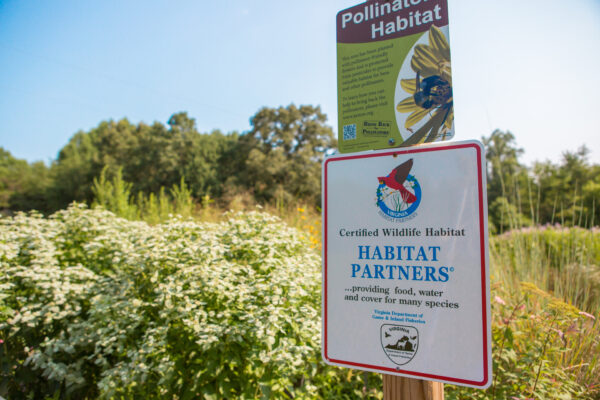
A pollinator demonstration garden completed by the DWR’s Habitat Partners Program.
- Habitat Resources – The DWR offers numerous resources on our website to help people get started and inspired on pollinator habitats.
- Habitat Partners© Education Program – For over a decade, this DWR program provided volunteer training for community leaders seeking to establish native plant demonstration gardens for wildlife viewing and public education outreach.
- Private Lands Wildlife Biologists (PLWBs)- For private landowners, DWR has a team of five PLWBs, hired jointly with Virginia’s Natural Resources Conservation Service (NRCS), that specialize in on-site landowner habitat evaluations followed by detailed management planning where appropriate. Working with native plant species is a cornerstone of their technical expertise.
Learn More About Our Work
- Six DWR Habitat Projects Funded by Restore the Wild (2020)
- Celebrate Pollinators (2020)
- Lost Before Found? (2018)
Watch: Pollinator Habitat Restoration at Lake Shenandoah in celebration of National Pollinator Week (2017)
How You Can Help
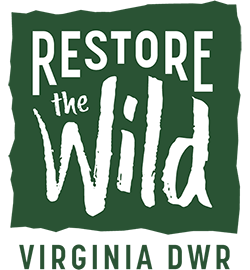 Purchase a Restore the Wild Membership to support the DWR’s habitat restoration work, such as what we have accomplished for Rusty Patched Bumble Bee and other pollinators. The membership also serves as your pass to visit DWR’s WMAs and Lakes, such as Highland WMA and Lake Shenandoah, throughout the Commonwealth.
Purchase a Restore the Wild Membership to support the DWR’s habitat restoration work, such as what we have accomplished for Rusty Patched Bumble Bee and other pollinators. The membership also serves as your pass to visit DWR’s WMAs and Lakes, such as Highland WMA and Lake Shenandoah, throughout the Commonwealth.- Plant native plants in your gardens, landscaping, and/or containers, especially the native plants favored by the Rusty Patched Bumble Bee. Native plants provide pollen and nectar for our native bees. Strive to plant a variety of flowers, shrubs, and trees, so that blooms will be present from April-September. This will provide the Rusty Patched Bumble Bee, which emerges in the early spring and is one of the last species to go into hibernation, with a constant food supply.
- If you are a private landowner, consider creating a pollinator habitat. Find out if your land is suitable for a project, by contacting your local PLWB or Marc Puckett, DWR’s Small Game Project Leader, at 434-392-8328, marc.puckett@dwr.virginia.gov. A PLWB can visit your property to help get you started and they are experts on multiple habitat incentive programs available through state and federal agencies.
- Avoid/remove invasive, non-native plants. They do not provide the benefits of native plants and can spread into your community’s natural areas, where they can take over native habitats.
- Provide natural, unmowed, brushy areas with undisturbed soil. Ground-nesting bees, such as the Rusty Patched Bumble Bee, need a safe place to build their nests and overwinter. Avoid disturbing soil by reducing any tilling or mowing where bees may be nesting.
- Support the natural areas in your community.
- Avoid/ limit the use of pesticides and chemical fertilizers. Pesticides cause lethal and sublethal effects to bees and other pollinators. Since Rusty Patched Bumble Bees nest in the ground, they may be particularly vulnerable to pesticides that persist in soils and lawns.
- Participate in Bumble Bee Watch, a citizen science project designed to collect data on bumble bee abundance and distribution.
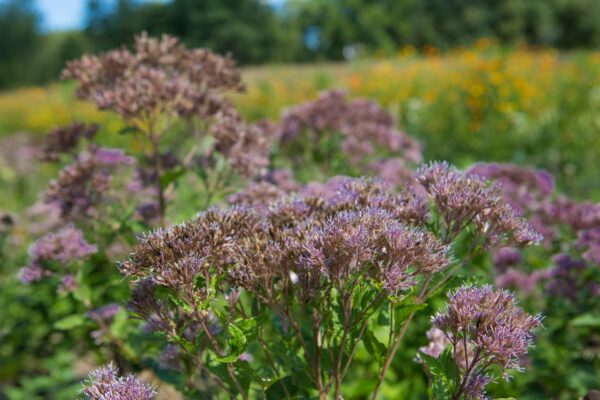
Joe Pye Weed, one of many native plants that supports pollinators and is favored by Rusty Patched Bumble Bee. Photo by Meghan Marchetti/ DWR.
Sources
Hatfield, R., Jepsen, S., Thorp, R., Richardson, L., Colla, S., Foltz, Jordan, S. & Evans, E. 2015. Bombus affinis. The IUCN Red List of Threatened Species 2015: e.T44937399A46440196. https://www.iucnredlist.org/ja/species/44937399/46440196 Downloaded on 24 June 2020.
Roth, Matthew and B. Moisset, R. McLeod, M. Quinn, and J.S. Ascher. May 26, 2006. “Species Bombus affinis– Rusty-patched Bumble Bee” BugGuide. Accessed online June 11, 2020 at https://bugguide.net/node/view/53929
Szymanski, J. et al. 2016. Rusty Patched Bumble Bee (Bombus affinis) Species Status Assessment: Final Report, Version 1, June 2016.
Thorp, Robbin, Evans, E., Jepsen, S., and Hoffman Black, S. “Rusty Patched Bumble Bee: Bombus affinis.” Xerces Society for Invertebrate Conservation. Accessed July 9, 2020 at https://www.xerces.org/
U.S. Fish and Wildlife Service. “Fact Sheet: Rusty Patched Bumble Bee (Bombus affinis),” U.S. Fish and Wildlife Service. January 10, 2017. Accessed June 9, 2020 at https://www.fws.gov/species/rusty-patched-bumble-bee-bombus-affinis
U.S. Fish and Wildlife Service. “Pollinators: Featured Pollinator.”June 17, 2019. Accessed July 9, 2020 at https://www.fws.gov/pollinators/features/rusty_patched_bumble_bee.html.
U.S. Fish and Wildlife Service. “Rusty Patched Bumble Bee (Bombus affinis)” January 23, 2020. Accessed June 26, 2020 at https://www.fws.gov/midwest/Endangered/insects/rpbb/.
U.S. Fish and Wildlife Service. “Rusty Patched Bumble Bee: Life History.” May 29, 2019. Accessed July 8, 2020 at https://www.fws.gov/species/rusty-patched-bumble-bee-bombus-affinis
U.S. Fish and Wildlife Service. “Rusty Patched Bumble Bee Map: Where the rusty patched bumble bee may be present.” Accessed June 24, 2020 at https://www.fws.gov/midwest/Endangered/insects/rpbb/rpbbmap.html
Species Profile Authors: Jessica Ruthenberg, DWR Watchable Wildilfe Biologist, with contributions from Celia Vuocolo of Piedmont Environmental Council, T’ai Roulston of Blandy Experimental Farm at University of Virginia, and Ellison Orcutt of Virginia DCR Natural Heritage Program.
Last updated: March 21, 2025
The Virginia Department of Wildlife Resources Species Profile Database serves as a repository of information for Virginia’s fish and wildlife species. The database is managed and curated by the Wildlife Information and Environmental Services (WIES) program. Species profile data, distribution information, and photography is generated by the Virginia Department of Wildlife Resources, State and Federal agencies, Collection Permittees, and other trusted partners. This product is not suitable for legal, engineering, or surveying use. The Virginia Department of Wildlife Resources does not accept responsibility for any missing data, inaccuracies, or other errors which may exist. In accordance with the terms of service for this product, you agree to this disclaimer.

